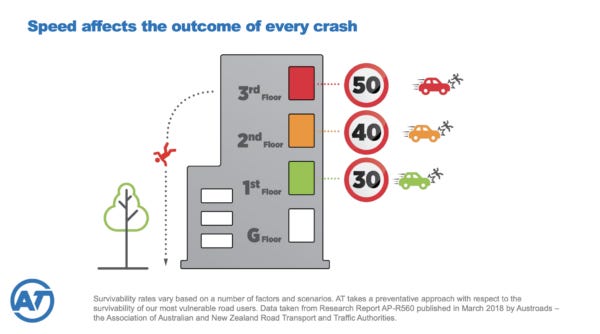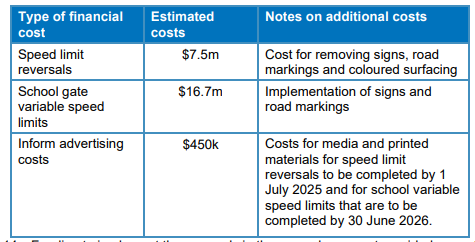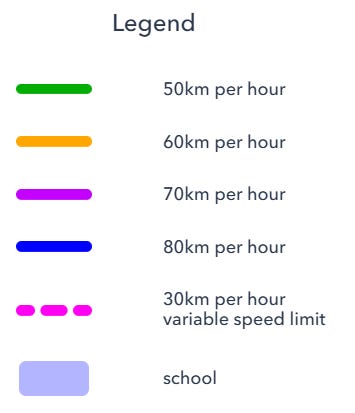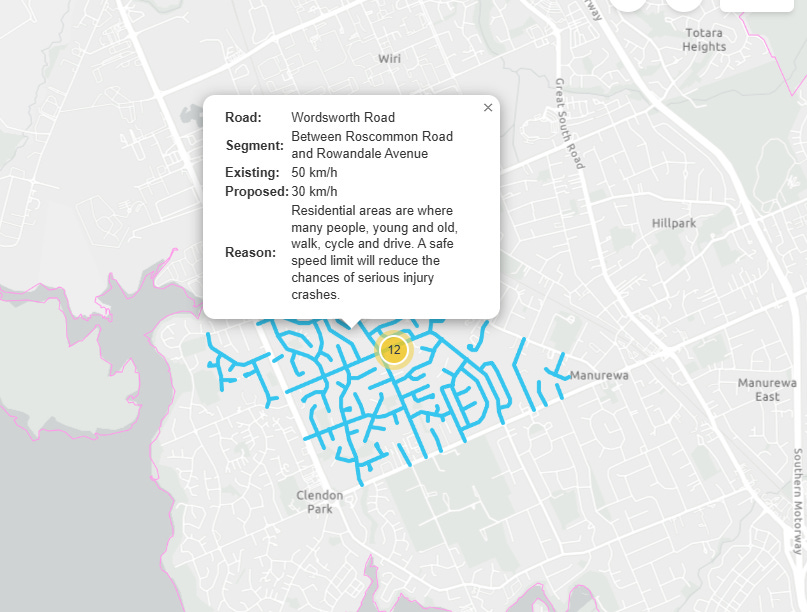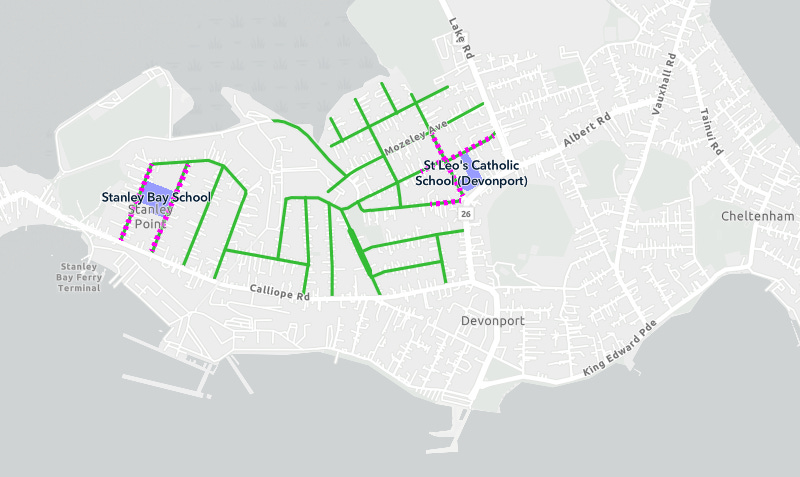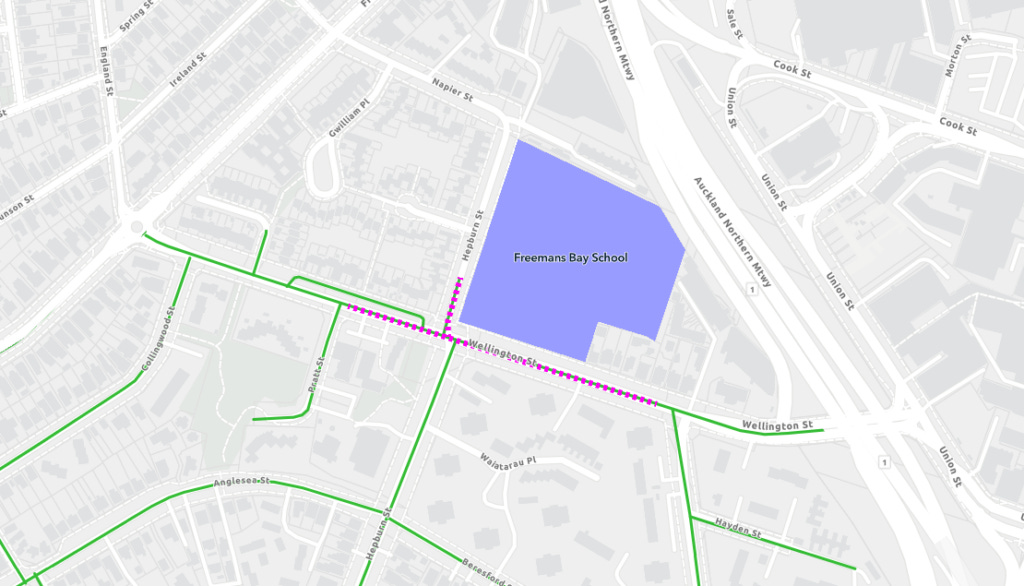Fixing the Kafkaesque speed rule impacts in Auckland
Last week, Auckland Transport released the list and map showing which streets and roads must have their speed limits increased due to the new Setting of Speed Limits 2024 rule from central government. As things currently stand, none of these changes will be consulted with the communities they impact. And that's a huge problem, as this looks to wipe out the years of (on the whole) decent work by AT's safety team which has been showing results.
In this post, we'll share some shocking examples that show the clear need for Ministerial discretion, proper consultation with the communities affected, and a review of AT's list.
The new Minister of Transport Chris Bishop, who has to oversee the rule his predecessor Simeon Brown wrote. has already opened the window to a cooling breeze of reason by encouraging community input in places that have pushed back. This might help mitigate some of the more perverse outcomes.
Auckland needs the same pushback, and the same promise from Bishop, because our situation is even more bizarre and unreasonable than other places.
We also need to talk about AT’s list and map, because there’s something worrying going on there.
And the Mayor, Councillors, Local Board members and citizens need to be all over AT and the Minister to sort this out.
The risks for Auckland
In a paper for the February AT Board meeting, AT staff outlined the key risks of the speed reversions. With Auckland Council is taking the reins and responsibilities of transport in our city, whatever happens next will sit in the lap of Councillors, as well as AT and the Minister.
The risks are around real life impacts, resources, and reputation.
The real life risk – more serious injuries and deaths, due to higher speeds – should go without saying. The resourcing risk – that AT will struggle to complete the work due to time and budget constraints – might be moot, depending on the outcome of a judicial review.
But AT is right to raise a red flag about reputation. Any death or serious injury (and every major crash, or traffic jam, or destroyed fence, or damaged shop or house) that can be ascribed to the higher speeds will be sheeted back to every person who initiated, signed off, and carried out this work, A terrible thing to have as your political or career epitaph.
Moreover, AT's map and list of planned reversions should be ringing loud alarm bells for everyone involved and affected: citizens, schools, board members, councillors, local boards, emergency responders, the health sector.
Why? Because the majority of the reversions to higher speeds are in neighbourhoods around schools.
And it's worse than that: they're happening because they're around schools. As per the Setting of Speeds rule, central government is unilaterally making councils raise speeds precisely because they were lowered to protect children.
The judicial review currently under way spells out that this is "perverse and unreasonable". It's Orwellian, in fact. It's also guaranteed to lead to serious injuries and deaths. Not just because 50kmh is exponentially more dangerous than 30kmh, but also because, thanks to safer speeds being in place for the last few years, more people are moving around on foot and by bike in these areas, including many, many children.
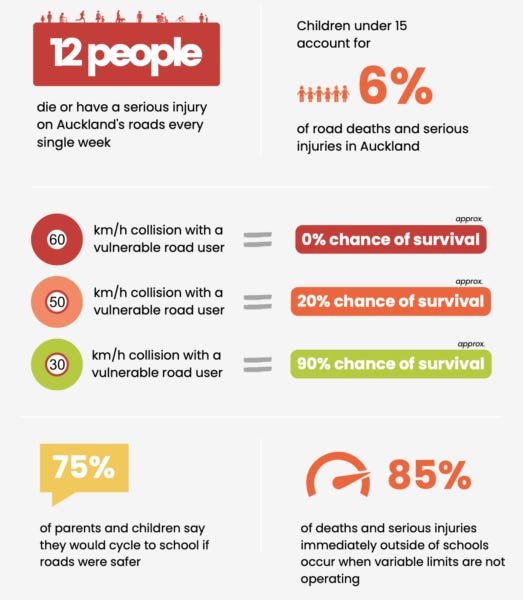
TL; DR: Auckland's children will be put in danger because Auckland tried to protect them
In the board paper, AT notes that other cities will be able to keep their 30kmh zones around schools because they were brought in on the basis of being good for the community as a whole.
But in Auckland, because AT was (momentarily) brave enough to say out loud that 30kmh neighbourhoods are (also) good for school children – that kids deserve safe streets from home to their destination, not just at the school gate – the new rule punishes those children by making their whole journeys to school more dangerous.
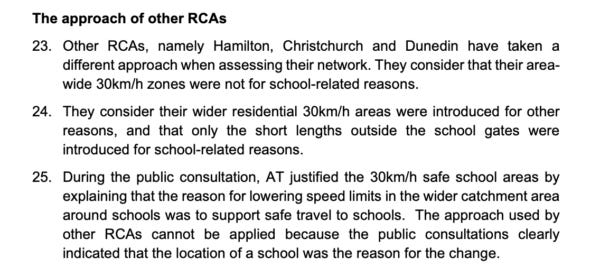
This seems to blatantly contravene the duty of care owed by our elected representatives, as well as the Land Transport Management Act, which tasks Road-Controlling Authorities with delivering "an effective, efficient and safe land transport system in the public interest."
There's a window of opportunity, right now
Thankfully, the new Minister of Transport, Chris Bishop, is already on the record as acknowledging the need for local input and discretion – helping local communities to help ensure the government gets things right in the setting of sensible speed limits.
This is a result of public pressure, and pleas from current and former National Cabinet ministers like the Minister for the South Island, James Meager, and Nelson Mayor Nick Smith. Bishop has now asked NZTA to revisit proposals in Rakaia, in Nelson, and “another couple of areas up north."
In today's post I'll share some of the many local examples that should spark similar calls for action by our elected representatives, and should lead to a similar Ministerial dispensation for Auckland.
The least the new Minister can do is ensure that the proposed changes are consulted locally, so he can move forward with the confidence of the communities he answers to.
So why is AT moving so fast?
Last week, Auckland Transport set out how they plan to meet the new requirements in two stages:
Stage 1 – March 2025
Speed limits on some urban connector (main) roads will be reversed from 50km per hour to a higher limit. Road signs will show the new speed limit. This is scheduled to be completed by 30 March 2025.
We'll also start removing speed limit road markings on some red road surfaces.
Stage 2 – by 1 July 2025
New variable 30km per hour signs on the 300 metre stretches of road outside the school gates where they will operate will begin to be installed. Signs will be either:
electronic, where the 30km per hour limit applies only when the sign is on (lit up)
static, where the 30km per hour limit applies at the specified times.
Why the rush to implement a programme that all evidence shows will cause significantly more harm to Aucklanders? Although AT has until 1st July 2025 to reverse (i.e. increase) speed limits, it is rushing towards a self-imposed deadline of 30th March. The speedy rollout not only raises the risks, it also leaves a gap of several months until time-variable speed limits are implemented outside schools. A danger double-whammy.
Not only that, the page communicating these reversals has no images nor mentions of the widespread scale of change. Hundreds of streets across the city will have their speed limits raised – but you have to click through to see the map.
Councillors and Local Boards should be concerned about AT's unseemly haste here, especially given how courageously it led this work in the first place (staff won a global road safety prize, for goodness' sake!), and how sluggishly AT has moved on other things.
Rushing is not good governance. Other councils are taking it slower. Moreover, ongoing judicial action has the potential to make this action moot, so it may be a waste of effort and money.
Another question for Councillors to ask AT: where is the money coming from to make these roads more risky? What budget is it being raided from? What work is being cancelled? And are Auckland's ratepayers okay with this?
At its October 2024 board meeting, AT outlined the costs of the basic reversal as $7.5m.
Now AT says it will be $8.8m, with government is potentially contributing 51% to the reversals - and no word yet on the additional costs for the school gate changes. None of this was budgeted for in the RLTP.
And all of this looks like Auckland Transport rushing to meet the lethal dictates of the new speed rule.
The big picture: absurdities all over the map, and mistaken inclusions
Looking at the map AT released, you can see the whole picture. First, here's the legend:
And if you look at the whole map, this is what you will see. Entire neighbourhoods are being changed, all over the city, with zero consultation. This is not the localism the coalition government promised. Nor is it the Local Board control and "giving Aucklanders back their say" that the Mayor sailed into office on.
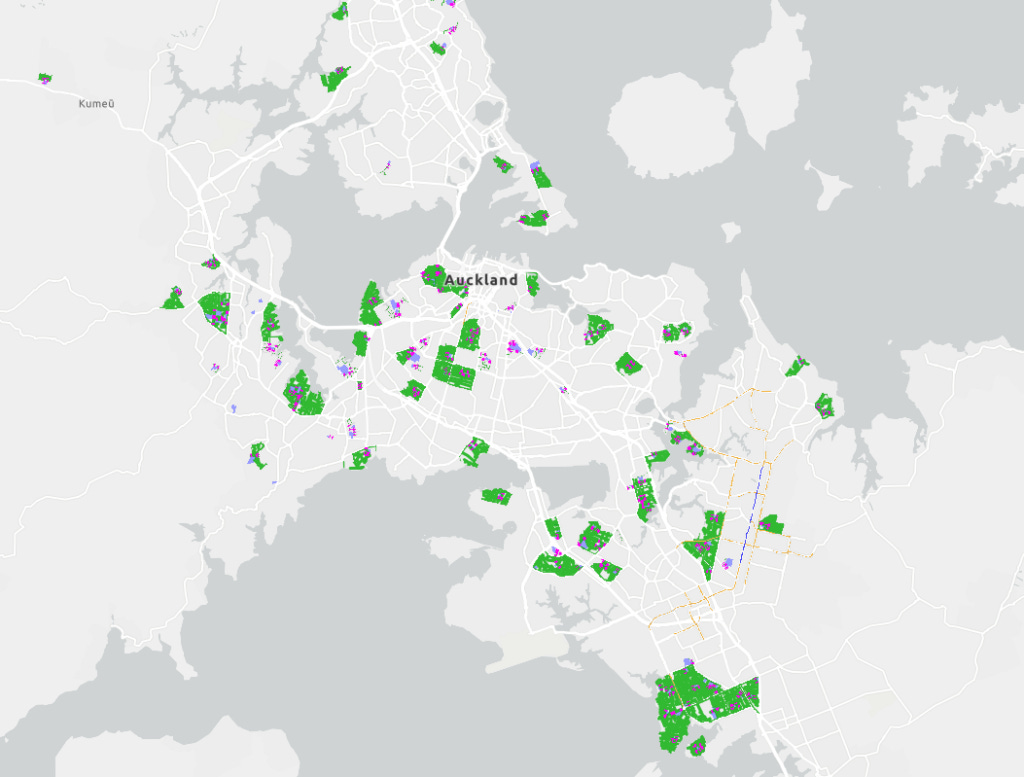
There's a lot of schools, eh?
When you zoom in, the first thing that sticks out is that the roads where speeds will be increased are mostly around schools – in many cases, this leads to absurd impacts. Here are a couple of examples.
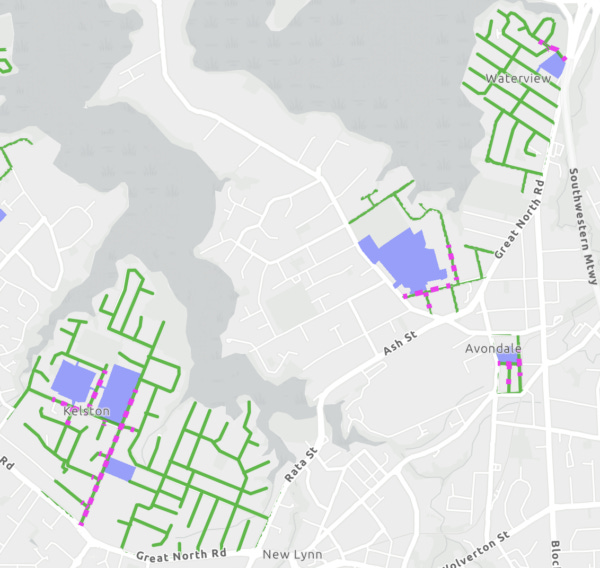
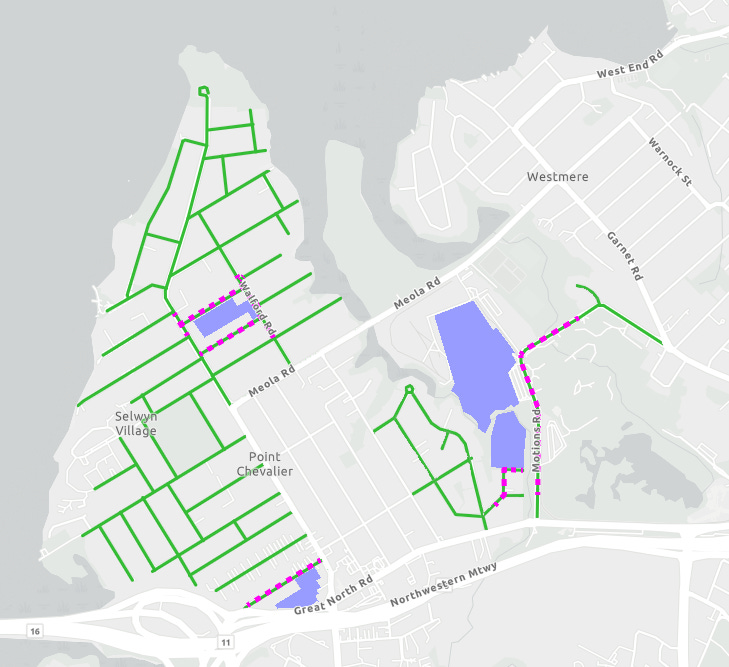
The reversals are mostly on quiet residential streets, including many cul de sacs, all around schools. As Alice Neville from The Spinoff put it:
busy residential neighbourhoods comprising narrow, heavily parked-up streets, in suburbs including Ponsonby, Eden Terrace, Point Chevalier, Waterview, Mt Eden, Balmoral, Sandringham, Mt Albert, Blockhouse Bay and Avondale in the central west; Parnell, Stonefields, Meadowbank and Glen Innes in the inner east; Stanley Bay, Belmont, Hauraki, Murrays Bay and Albany on the North Shore; Kelston, Te Atatū South, Lincoln and Rānui out west; and Māngere, Māngere Bridge, Otāhūhū, Ōtara and Manurewa in the south; and Pakuranga, Mellons Bay and Cockle Bay out east.
The directive doesn't originate, as Neville's article implies, from the Ministry of Transport. It comes directly from the former Minister of Transport, Simeon Brown. His rule mandated speed limit reversals (raises) on 'specified road[s]', defined as:
(a) a road—
(i) that is a local street (residential or neighbourhood street); and
(ii) for which the Agency (as RCA) or the territorial authority set a permanent speed limit of 30 km/h on or after 1 January 2020; and
(iii) the reason or one of the reasons for setting that speed limit was because there is a school in the area;
or
(b) a road—
(i) that is an urban connector, a transit corridor, an interregional connector, or a rural connector (as those classes of road are described in Schedule 3) and for which, in the case of a rural connector only, the Agency (as RCA) is the road controlling authority; and
(ii) for which the Agency (as RCA) or a territorial authority set a permanent speed limit on or after 1 January 2020; and
(iii) for which the previous speed limit is higher than the amended speed limit:
The key point is (a) (iii) "the reason or one of the reasons for setting that speed limit was because there is a school in the area;".
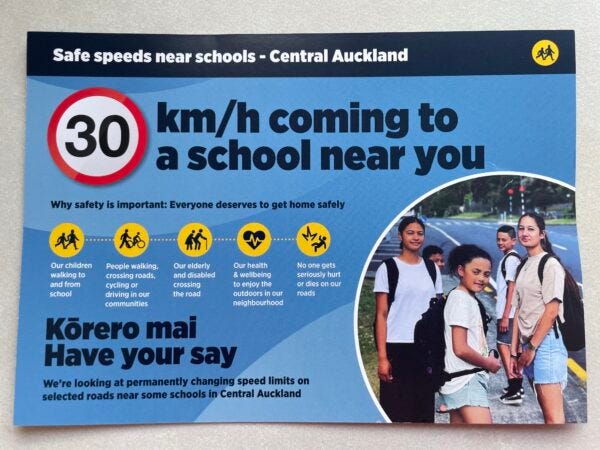
Yes, many – but not all – of Auckland's speed limit reductions were implemented specifically to ensure safer neighbourhoods for walking and cycling around schools. But AT looks to have been overly eager with their rush to implement reversals.
For example, this is what is being reversed in Manurewa:
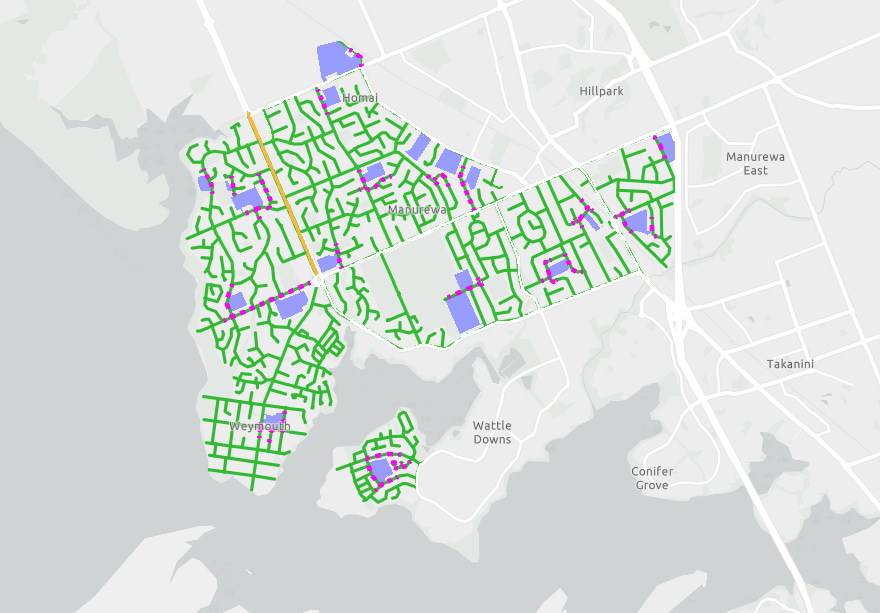
But when you look at the consultation work AT did only a few years ago (for part of the area shown), you find something interesting. Only some of the roads state the reason as being near schools. Others are due to being residential areas.
Ponsonby and Freeman's Bay contain plenty of similar examples, where AT's stated reason for speed reductions is that they are residential areas. Someone needs to do a deep dive on this.
AT might argue they need to undo the whole neighbourhood because they mentioned schools at all during the broader consultation. By that logic, shouldn't they also delete safe speeds in town centres where any consultation maps showed the existence of schools? Take Devonport, for example...
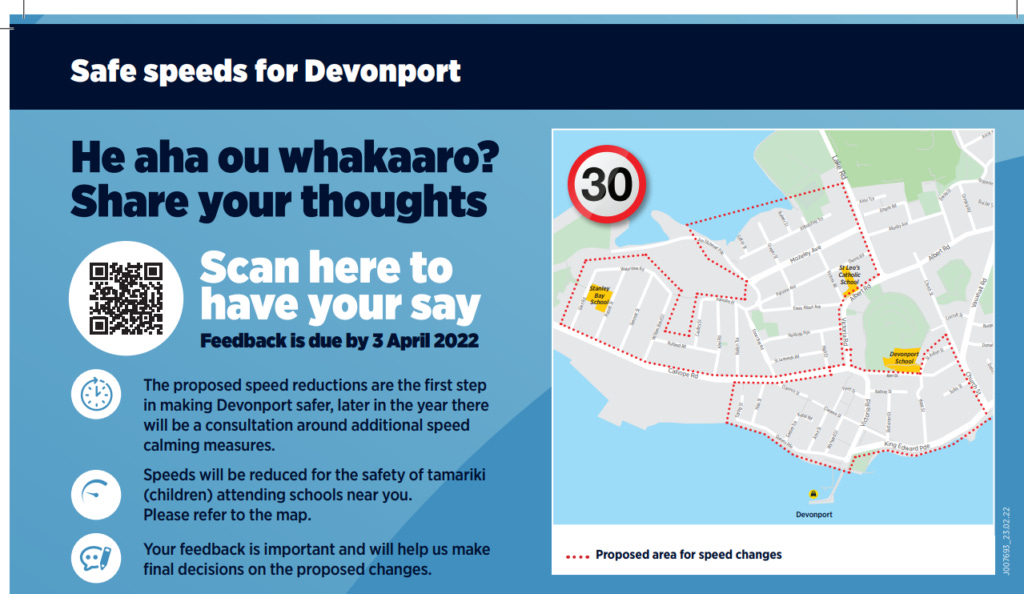
See the missing area? The point isn't that Devonport Town Centre (and others like Takapuna Town Centre) should revert to 50kmh zones. The question is, why AT are applying such a broad brush approach in some areas.... but not others?
And what other areas might not need reversing? Because this is not the only anomaly we've found.
Even if AT is following the rule to the letter, how does any of this make sense?
If you take Auckland Transport's interpretation as a proper, on the grounds that the speed reversal rule targets schools and the residential areas around them, it leads to some very perverse unintentional outcomes that should raise anyone's eyebrows.
Here are a few of the most outrageous examples.
1) Higher speeds outside a school for the blind
The speed limit will go up to 50kmh on Mcvilly Road outside the Homai Campus in Manurewa, a "specialist school for children and young people who are blind, deaf blind or have low vision." That's right: the government is forcing Auckland Transport to increase speeds around a school for the blind, and Auckland Transport is doing it.
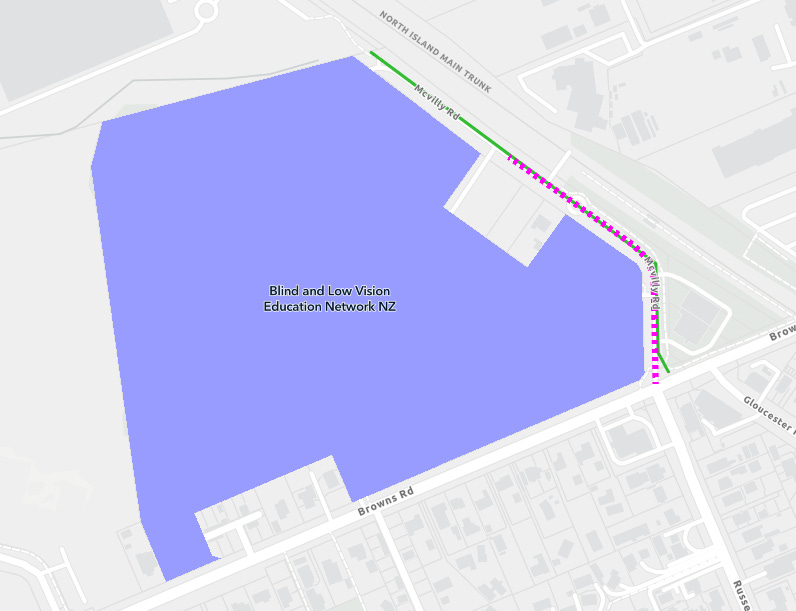
Note the pink dots on the map above: these indicate "variable" speeds of 30kmh, which apply strictly at the beginning and end of the school day. For the remaining ~23 hours a day, this little street (below) will be a 50kmh road.

2) Higher speeds in heritage neighbourhoods
Look at Ponsonby, where 50kmh speeds are set to be (re)implemented on short streets full of shops like Pompallier Terrace, and narrow side streets, many of them steep. Many also include tree-rich traffic-calming that dates back decades, from when residents were fed up with witnessing head-on crashes with a closing speed of minimum ~100kmh.
Central government's speed rule forces AT to mandate a blanket return to 50kmh across this neighbourhood, where many children walk to school, and many locals stroll and bike to the shops, restaurants and work. It's perverse.
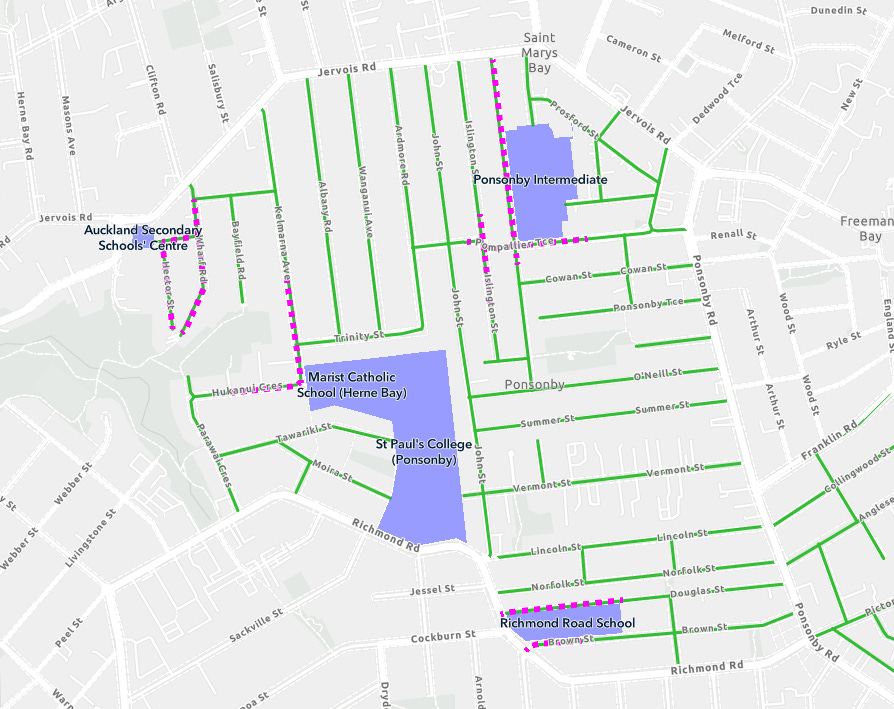
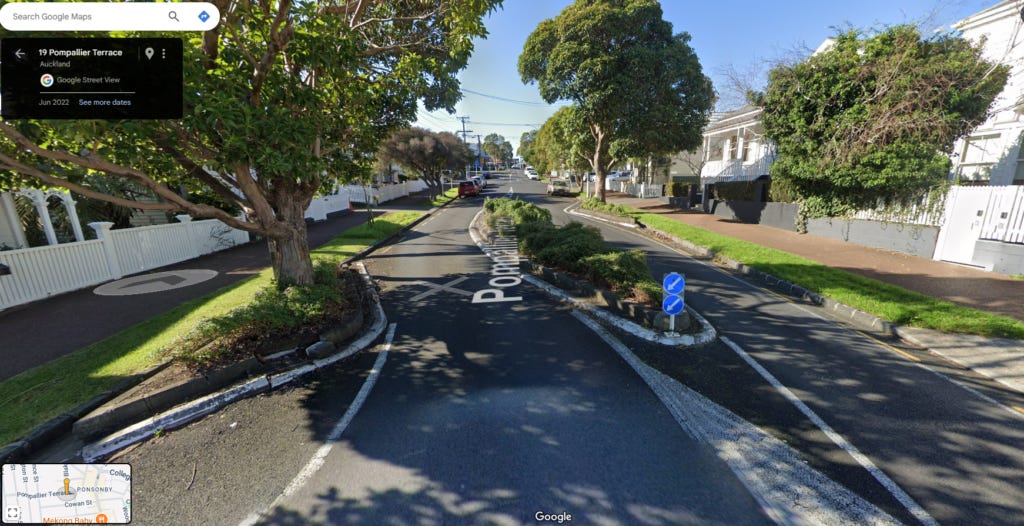
3) Tiny cul-de-sacs will be 50kmh streets... because they're near a school
Due to the absurdly tight definition of a "school gate", this 100m dead-end stretch of Roberts Road, a cul de sac near Freyberg Community School in Te Atatū, will require 50km signs. Likewise all of those short side streets. What a waste of money and a pointless exercise.
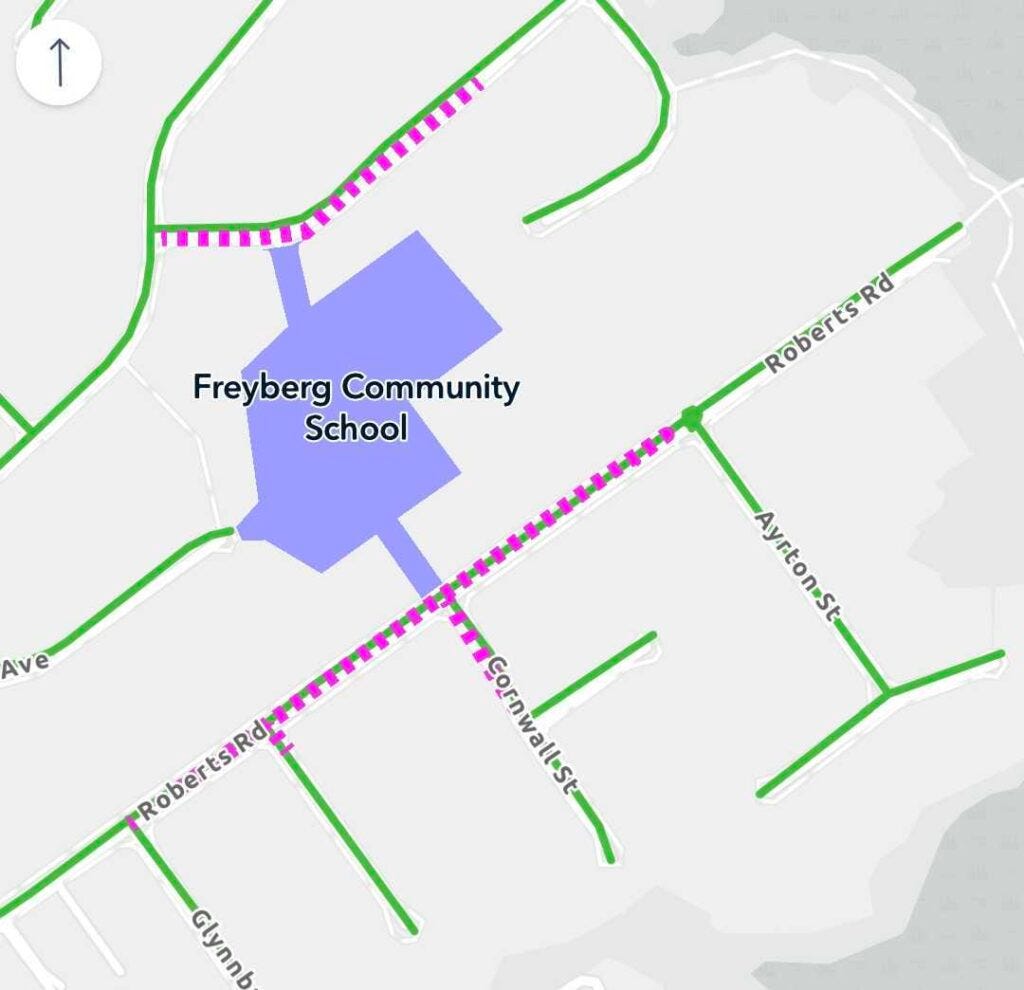
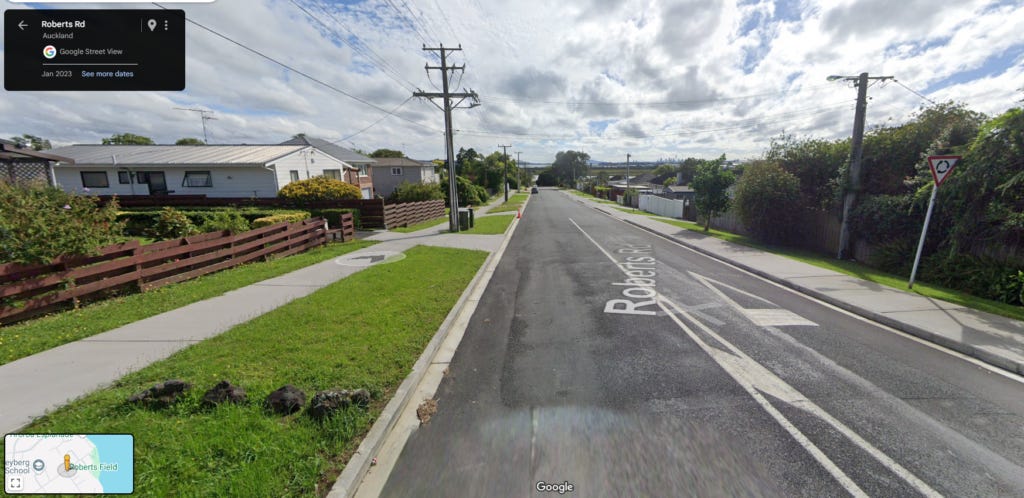
4) Some places will be safe to walk to the shops – but not to the school next door
Over the last few years, in some town centres - Ōtara and Ōtahuhu for example - 30kmh zones have been introduced around busy local shops as well as adjacent schools. But because of the weird wording of the speed rule, shops will be kept safer for people, while schools and neighbourhoods will revert to speedy traffic.. even though they're right next to each other.
(On the screenshots below, our blue lines show 30kmh zones that can stay – for some reason, AT's maps don't specify these.)
What does this mean for kids and families going to the shops on the way to or from schoo,, to after school jobs, to catch a bus? Is this fair or sensible? Is this what the communities want?
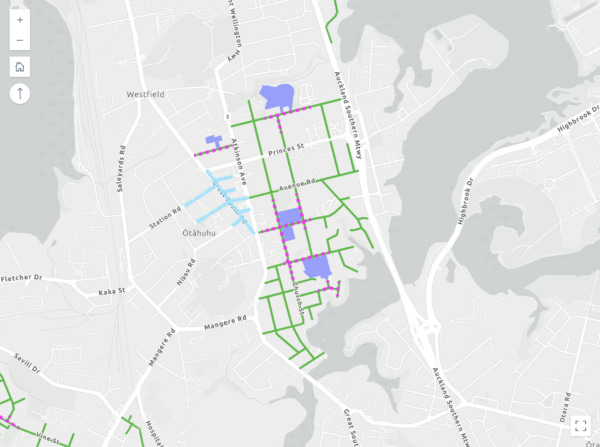
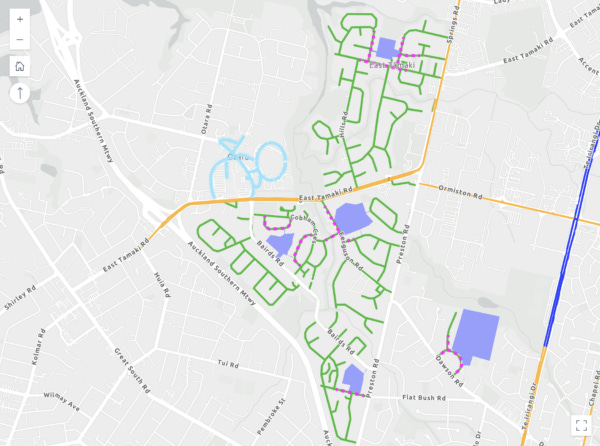
5) In some places, you'll have to speed up when you see a school
Another hugely perverse outcome is that these reversals also create situations where speed limits go up when approaching a school.
Look at Freeman's Bay School. If you approach from the west (Franklin Road), the north (Napier Street), or the east (Union Street), you'll actually be encouraged to increase your speed from 30km/h to 50km/h – slowing down again if it's "drop-off" or "pick-up" time, but otherwise roaring past at 50km/h.
And these are just a few examples. Feel free to share more in the comments.
This is a Kafkaesque nightmare for Aucklanders, for AT, for Council, for Local Boards, and for the Minister.
There's no rhyme or reason, no consultation, no chance to raise objections...
...unless the Minister extends to Auckland the same discretion he's already offered to Rakaia, Nelson, "up north", and probably other places too. We deserve no less.
Do any of the schools involved support higher speeds? Will the thousands of people affected – parents, kids, elderly residents, regular people just trying to walk, bike or cross the road to catch the bus in safety – benefit from the blanket returns to 50kmh?
Consultation would enable responsible conversations. Most 30kmh areas have been in place long enough to deliver actual data, not just reckons. It's a reasonable way to find out if people - local residents, schools, shopkeepers, emergency responders, police – really do want increased speeds around the clock on all these little side streets, or if they're happy with how things are working now.
Big questions ahead for those in charge of Auckland
Here's the thing. Across the country, many other councils – regardless of where they sit on the political spectrum – have been raising their voices in opposition to the unilateral speed changes. This includes trying in any way possible to ensure dangerous roads are not returned to dangerous speeds.
But in Auckland, despite a robust submission on the speed rule last year, Auckland Council and Auckland Transport have been strangely quiet. A vote at last month's Transport, Resilience and Infrastructure Committee narrowly failed, even though there was strong concern about the schools aspect. Will this be revisited at this week's meeting?
The former Minister of Transport might have been comfortable with relying on a very light Regulatory Impact Statement, but the current Minister, Mayor, Councillors and AT cannot claim the same ignorance of the evidence.
AT and Council may feel they're legally obliged to make the changes. But as the Road-Controlling Authority responsible, they also have legal obligations to keep people safe.
Responsible governance in this situation looks like:
asking hard questions about AT’s rapid rollout of reversals
checking their list of areas, which seems over-eager
requesting the minister enable consultation, to help ensure social license – and legal protection
and also: hitting the brakes, to wait for the judicial review to play out
It also means questioning the utility of the variable speed limits around "pick up and drop off" hours. These aren't really the answer. Besides being imposed without consultation, they don't protect children and families for the full length of their journeys to school. The evidence from research in Auckland shows that 85% of Deaths and Serious Injuries outside schools occur outside those hours. And families whose children walk and bike to school know that the bit at the school gate is just one small part of the heat-map of risk.
Above all, we know this: the work that Auckland, and the rest of the country, has been doing is lowering our road toll.
What we have is working. We should be able to keep it.
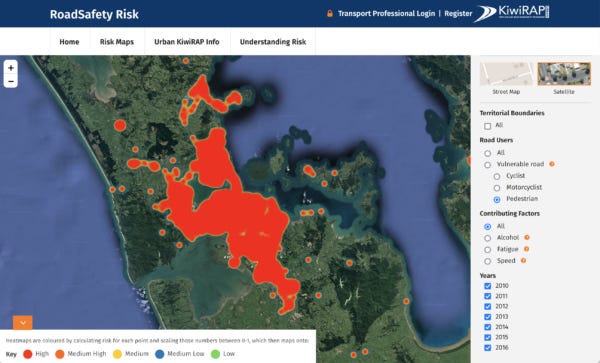
What can you do? Glad you asked!
Tomorrow we'll have a post with actions you can take, and some tips – for now, here are some immediate actions.
Contact your local school, especially if you have or know kids who attend. Talk to other local parents. Ask them if they know this is happening, and encourage them to do something. Share the map and the list, tell them what looks set to happen, and that it is very unsafe.
Contact AT and state your concerns. Ask for data: crashes in your area, and the impacts of the existing safe speed zones. Ask too about the cost of the reversion, and where the money is coming from. You can also write directly to the AT Board, who as responsible governors, should be asking these questions on our behalf. They have access to the evidence, why not hold their horses?
Contact your Councillor and Local Board members. Ask who they've talked to about this. Ask why Auckland is buckling so quickly, when a) there is a judicial review under way, and b) we have the evidence safe speeds work, and c) other towns and cities are being granted the option of consultation.
Contact your MP, no matter which party they're from: we need a gentlepersons agreement on this sort of thing. Everyone elected to Parliament has a duty to put our wellbeing first.
And above all...
Email the Minister of Transport to express your concern. He's already exercising discretion around the part of the rule that targets schools. Ask him to extend the same courtesy to Auckland. At the very least, demand consultation on every area for reversion to higher speeds.
We expect the Minister of Transport to take positive action and do the right thing – for rational reasons, and not just because it's going before the courts.
Remember how the key rationale for the widespread speed reversions was "productivity"? All the evidence strongly indicates that safer speeds save time and money as well as lives. On top of the hundreds of lives lost, communities damaged, and roads that grind to a halt for clean-up, road crashes cost New Zealand $9,770,000,000 a year – yes, almost ten billion dollars, ~4 per cent of our GDP. (NB That's 2021 numbers, likely higher now.)
If as he says, Chris Bishop really wants an urbanist future for Auckland and other New Zealand cities, a key element will be making sure urban streets and roads enable more walking and cycling – as well as safer travels by car, lower disruption and less congestion from crashes, and a positive effect on liveability and productivity.
From Brussels to Bologna, to back here in Tāmaki Makaurau, safe speeds are integral to getting this right. As the executive director of the European Transport Safety Council wrote this week:
When you set the speed to 30 km/h, it’s like waving a magic wand over your city. People walk and cycle more. The usage of shared mobility schemes increases. Air pollution can go down.
And empowering communities to make these choices is the way to go.





